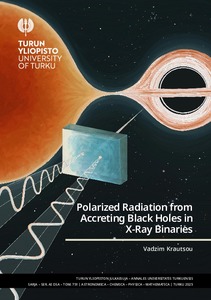Polarized radiation from accreting black holes in X-ray binaries
Krautsou, Vadzim (2025-12-12)
Polarized radiation from accreting black holes in X-ray binaries
Krautsou, Vadzim
(12.12.2025)
Turun yliopisto
Julkaisun pysyvä osoite on:
https://urn.fi/URN:ISBN:978-952-02-0453-2
https://urn.fi/URN:ISBN:978-952-02-0453-2
Kuvaus
navigointi mahdollista
kuvilla vaihtoehtoiset kuvaukset
taulukot saavutettavia
looginen lukemisjärjestys
kuvilla vaihtoehtoiset kuvaukset
taulukot saavutettavia
looginen lukemisjärjestys
Tiivistelmä
Accreting stellar-mass black holes are known to be one of the most effcient converters of gravitational energy into radiation in the Universe. They reside in binaries, where the normal type companion star supplies matter to the compact object. When spiraling into a black hole, matter forms an accretion disk around it, which exposes itself through a rich phenomenology across the electromagnetic spectrum: spectral state transitions, relativistic jet launching, and variability on timescales ranging from milliseconds to years.
This dissertation is devoted to the study of multiwavelength polarization from black hole X-ray binaries (BHXRBs), both low-mass and high-mass. Over the years of my work on this dissertation, I have carried out the most comprehensive survey to date of their optical polarization behavior: 12 black hole systems have been studied in total, for fve of which the intrinsic optical polarization has been reliably detected, and for the rest it has been shown to be absent at the level better than 0.5%. In two of these sources, we discovered orbital variability of optical polarization and developed models to explain it. We showed that high-precision polarimetric observations can be used to independently estimate the orbital parameters of such systems, which is crucial when studying their physics, and provided models and tools for that.
Midway through my PhD journey, the IXPE satellite was successfully launched, naturally shifting the focus of my interests towards X-ray polarimetry. During the frst months of its operation, I performed an optical polarimetric campaign, support¬ing the frst IXPE observation of the black hole X-ray binary, Cyg X-1. The result of this joint observation was the frst reliable detection of the X-ray polarization from BHXRB, which turned out to be unexpectedly high, with polarization angle aligned with the direction of the radio jet as well as with orbital axis, as evidenced by optical polarimetry. This discovery showed that the hot corona responsible for producing the hard X-ray spectrum is spatially extended in the plane perpendicular to the jet axis, rather than aligned with it, thereby ruling out models that place the corona along the jet direction. Later on, I organized simultaneous observations with IXPE, the Very Large Array (VLA), DIPol-2, and other facilities, which enabled the frst detection of radio polarization in Cyg X-1 and led to the discovery of its X-ray polarization variability.
Together, these studies establish multiwavelength polarimetry as a unique tool for probing the geometry and dynamics of accreting black holes, laying the groundwork for future observational campaigns with next-generation polarimetric facilities.
This dissertation is devoted to the study of multiwavelength polarization from black hole X-ray binaries (BHXRBs), both low-mass and high-mass. Over the years of my work on this dissertation, I have carried out the most comprehensive survey to date of their optical polarization behavior: 12 black hole systems have been studied in total, for fve of which the intrinsic optical polarization has been reliably detected, and for the rest it has been shown to be absent at the level better than 0.5%. In two of these sources, we discovered orbital variability of optical polarization and developed models to explain it. We showed that high-precision polarimetric observations can be used to independently estimate the orbital parameters of such systems, which is crucial when studying their physics, and provided models and tools for that.
Midway through my PhD journey, the IXPE satellite was successfully launched, naturally shifting the focus of my interests towards X-ray polarimetry. During the frst months of its operation, I performed an optical polarimetric campaign, support¬ing the frst IXPE observation of the black hole X-ray binary, Cyg X-1. The result of this joint observation was the frst reliable detection of the X-ray polarization from BHXRB, which turned out to be unexpectedly high, with polarization angle aligned with the direction of the radio jet as well as with orbital axis, as evidenced by optical polarimetry. This discovery showed that the hot corona responsible for producing the hard X-ray spectrum is spatially extended in the plane perpendicular to the jet axis, rather than aligned with it, thereby ruling out models that place the corona along the jet direction. Later on, I organized simultaneous observations with IXPE, the Very Large Array (VLA), DIPol-2, and other facilities, which enabled the frst detection of radio polarization in Cyg X-1 and led to the discovery of its X-ray polarization variability.
Together, these studies establish multiwavelength polarimetry as a unique tool for probing the geometry and dynamics of accreting black holes, laying the groundwork for future observational campaigns with next-generation polarimetric facilities.
Kokoelmat
- Väitöskirjat [3042]
